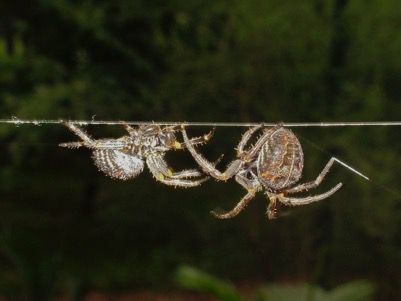Spider Etiquette in Crowded Places
I joined a tream of investigators from six different nations to make detailed field observations in southern Brazil on the fascinating social spider Parawixia bistriata. During the day, hundreds of these spiders doze quietly together in a bivouac, a soccer-ball-sized huddle of hundreds of spiders in a bush or tree. The bivouac sits at the centre of a network of thick silk lines which radiate out to adjacent trees and bushes. Things change dramatically at sunset; the spiders move out along the silk lines (see banner picture above) and build many adjacent orb webs, normally one per spider. Before daybreak, each spider consumes its own web and returns to the safety of the bivouac.
 Two spiders passing each other, without any aggressive interaction, while depositing silk on the main support lines before initiating web building
Two spiders passing each other, without any aggressive interaction, while depositing silk on the main support lines before initiating web building
Darwin almost certainly observed this species while travelling overland in Argentina in October 1832, describing them in his Voyage of the Beagle as “many large black spiders, with ruby-colored marks on their backs, having gregarious habits.” After describing their adjacent individual webs attached to common lines, he went on to remark that “this gregarious habit, in so typical a genus as Epeira, among insects, which are so bloodthirsty and solitary that even the two sexes attack each other, is a very singular fact.”
Almost two centuries later, we now understand the spiders’ behavioral strategies that keep the peace and prevent these dangerous well-armed carnivores from getting into costly confrontations with their neighbors. Early in the evening, when there is still plenty of web-building space, spiders building their webs bounce up and down at potential intruders. Invariably, the intruder moves off, looking for its own vacant space within the network of permanent silk lines.
However, things change once all the potential web-building sites become occupied. Webless spiders now ignore a resident’s bounces and sit patiently at the web perimeter; they are occasionally rewarded by sneaking in to share a large insect prey with the resident. Modeled in terms of hawk-dove game theory, this switch in the behavioral strategy of webless spiders makes perfect sense. Early in the evening all spiders conventionally agree to respect the resident’s ownership because there is a high chance of finding a web-building site. Later on, when there is little chance of finding a web-building site, it is better to ignore the bouncing and hang around an existing web rather than search. But it is never worth fighting; one night’s food is not worth risking death for. Our paper, Wenseleers et al (2013) Am Nat, 182: 120-129 combines traditional natural history observations with modern thinking about alternative behavioral strategies


